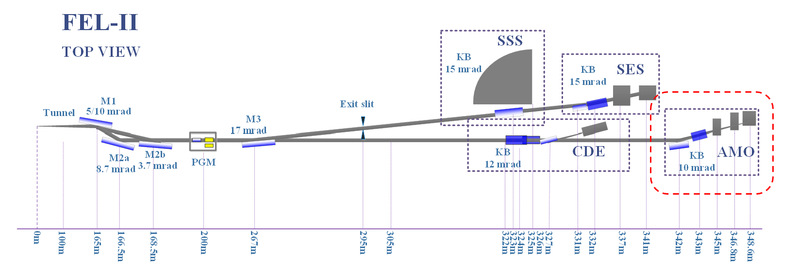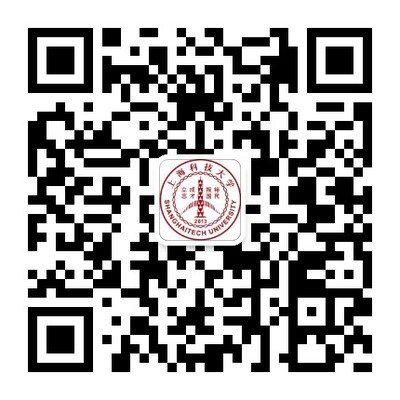原子分子反应成像实验站(AMO)是硬X射线自由电子激光装置(XFEL)首批建设的六大实验站之一。该实验站位于FEL-II光束线近端实验大厅,工作于0.2-3.0 keV X射线波段,依托高重复频率X射线自由电子激光技术,具备超高峰值亮度、高平均亮度、飞秒级超快脉冲、纳米级空间分辨能力以及飞秒级时间分辨能力,可实现对原子分子尺度物质动态过程的观测与控制。
作为国家重大科技基础设施的核心组成部分,该实验站聚焦分子反应动力学、化学反应调控、量子调控等前沿领域,通过高时间分辨与高空间分辨的协同,为原子分子体系电子态跃迁、化学键演化等超快过程提供研究手段。实验站配置的先进终端系统支持X射线泵浦-X射线探测等超快实验模式,能够满足多用户并行研究需求,并与装置内其他实验站(如单分子衍射、电子结构解析等)形成互补,共同覆盖0.1-13 keV光子能量范围的研究能力。
本实验站的建设目标是为材料、能源、物理与化学、生命及医药等领域提供战略性研究平台,推动在原子分子和电子尺度上解析物质动态过程,助力解决国家战略科技中的关键科学问题。

原子分子反应成像实验站由多功能成像系统和复合电子离子磁瓶谱仪系统构成。
多功能成像系统
多功能成像系统基于硬X射线自由电子激光(FEL)的原子尺度波长(埃级)与飞秒级脉宽,实现在飞秒时间及原子空间尺度观测单原子/分子反应过程,包括:
1. 硬X射线单原子/分子成像,研究X射线环境下原子内壳层电子成像、分子能量/电荷输运、高价离子QED效应、X射线诱导化学反应、X射线量子光学等;
2. 利用原子内禀物理过程标定X射线激光参数(脉宽、波长);
3. 分子解离电离动力学中电子-原子核强相互作用及量子纠缠演化研究;
4. X射线波段多光子非线性过程(如非顺序双光子双电离、高阶量子态巨共振、“空心原子”现象等);
5. 结合飞秒泵浦-探测技术,通过光谱、动量分布等手段实时追踪分子结构变化及反应通道控制。
科学应用
1)原子内壳层的多光子多电离非线性研究
2)分子内中能量、电荷转移动力学过程研究
3)X射线激光脉冲特性的标定
4)X射线量子光学
5)光电子成像和纳米等离子体
复合电子离子磁瓶谱仪系统
磁瓶谱仪通过非均匀磁场约束电子,经MCP探测并计算动能。传统设计因磁铁间距限制无法电子-离子符合测量。本研究设计45°旋转锥形电极离子谱仪,缩短磁铁间距,维持电子ΔE/E~2%(最高600 eV),实现离子3D动量测量。
- 技术参数:
可以同时测量电子和离子,电子收集效率>95%,最大电子动能600 eV,分辨E/E ~2%;离子收集效率100%,离子动能<15 eV,分辨E/E~4%。
- 关键设备:
1) 磁瓶电子飞行时间谱仪:利用磁瓶效应准直电子,Simion模拟显示2米谱仪长度下动能分辨达1.5%,计划通过减速电压优化至0.5%。磁场需满足Bf/Bi小且过渡区短,同时符合绝热近似条件;
2) 离子三维速度成像谱仪:采用锥形电极(极角25°和65°)实现源区三维聚焦,40°间隔保障电子通过。模拟显示离子动能2-16 eV时分辨优于1.5%。可选MCP+CCD(群体动量分析)或MCP+DLD(单粒子三维动量测量,符合实验能力但事例率0.2/脉冲);
3) 离子3D成像谱仪:锥形电极(25°/65°极角)实现全角度聚焦,MCP+DLD支持单粒子动量测量(事例率0.2/脉冲)。
4) 超声分子束:20μm喷嘴产生冷分子束(约几K),主腔真空<10⁻¹⁰ mbar。三级差分抽气系统(源腔2×10⁻⁴ mbar→一级差分10⁻⁷→二级差分10⁻⁹→主腔),匹配脉冲喷嘴与FEL同步以降低气体负载和温度。
咨询委员会:
Kiyoshi Ueda (Tohoku University & ShanghaiTech University)
Christoph Bostedt (Paul Scherrer Institute/EPFL)
Carlo Callegari (FERMI Elettra Sincrotrone Trieste)
James P. Cryan (SLAC National Accelerator Laboratory)
Dajun Ding (Jilin University)
Till Jahnke (European XFEL)
Kenichi L. Ishikawa (University of Tokyo)
Jon Marangos (Imperial College London)
Fernando Martín (Universidad Autónoma de Madrid)
Michael Meyer (European XFEL)
Maria Novella Piancastelli (Sorbonne Université)
Jan-Erik Rubensson (Uppsala University)
Sang-Kil Son (Center for Free-Electron Laser Science/DESY)
Hans Jakob Wörner (ETH Zürich)
Atom Molecule Optics (AMO) Experimental Station is one of the first six experimental stations constructed at the Hard X-ray Free-Electron Laser Facility (XFEL). Located in the near-hutch experimental hall of the FEL-II beamline, this station operates in the 0.2-3.0 keV X-ray band. Leveraging high-repetition-rate X-ray free-electron laser technology, it features ultra-high peak brightness, high average brightness, femtosecond-scale ultrafast pulses, nanometer-level spatial resolution, and femtosecond-level temporal resolution. These capabilities enable the observation and control of dynamic processes at the atomic and molecular scale.
As a core component of a major national science and technology infrastructure, the station focuses on cutting-edge fields such as molecular reaction dynamics, chemical reaction control, and quantum manipulation. By synergizing high temporal and spatial resolution, it provides research capabilities for studying ultrafast processes like electron state transitions and chemical bond evolution in atomic and molecular systems. The station's advanced end-station systems support ultrafast experimental modes like X-ray pump-X-ray probe, catering to the needs of multiple parallel user experiments. It complements other facility stations (such as single-molecule diffraction and electronic structure analysis), collectively covering a research photon energy range of 0.1-13 keV.
The station's construction aims to provide a strategic research platform for fields including materials science, energy, physics and chemistry, life sciences, and medicine. It seeks to advance the understanding of dynamic material processes at atomic, molecular, and electronic scales, thereby contributing to solving key scientific challenges in national strategic science and technology initiatives.

The Atom Molecule Optics (AMO) Experimental Station comprises a Multifunctional Imaging System and a Coincidence Electron-Ion Magnetic Bottle Spectrometer System.
Multifunctional Imaging System
Leveraging the atomic-scale wavelength (Ångström-level) and femtosecond pulse duration of the Hard X-ray Free-Electron Laser (FEL), this system enables the observation of single atom/molecule reaction processes at femtosecond temporal and atomic spatial scales. Its capabilities include:
1) Hard X-ray single atom/molecule imaging, studying: inner-shell electron imaging in atoms, molecular energy/charge transport, QED effects in highly charged ions, X-ray-induced chemical reactions, and X-ray quantum optics within the X-ray environment.
2) Calibrating X-ray laser parameters (pulse width, wavelength) using intrinsic atomic physical processes.
3) Investigating strong electron-nucleus interactions and quantum entanglement evolution in molecular dissociation and ionization dynamics.
4) Studying X-ray band multiphoton nonlinear processes, such as non-sequential two-photon double ionization, giant resonances of high-order quantum states, and "hollow atom" phenomena.
5) Real-time tracking of molecular structural changes and reaction pathway control via spectroscopy and momentum distribution measurements, combined with femtosecond pump-probe techniques.
Scientific Applications:
1) Multiphoton multielectron ionization nonlinear studies of atomic inner shells.
2) Dynamics of intra-molecular energy and charge transfer processes.
3) Calibration of X-ray laser pulse characteristics.
4) X-ray quantum optics.
5) Photoelectron imaging and nanoplasmonics.
Coincidence Electron-Ion Magnetic Bottle Spectrometer System
The magnetic bottle spectrometer confines electrons using an inhomogeneous magnetic field, with their kinetic energy measured via MCP detection and calculation. Traditional designs cannot perform electron-ion coincidence measurements due to magnet spacing limitations. This research employs a novel 45° rotated conical electrode ion spectrometer, which shortens the magnet spacing while maintaining electron resolution (ΔE/E ~ 2% up to 600 eV), enabling 3D ion momentum measurement.
- Technical Parameters:
Simultaneous electron and ion measurement with electron collection efficiency >95%, maximum electron kinetic energy 600 eV, resolution ΔE/E ~ 2%, ion collection efficiency 100%, ion kinetic energy < 15 eV, resolution ΔE/E ~ 4%.
- Key Equipment:
1) Magnetic Bottle Electron Time-of-Flight Spectrometer: Collimates electrons using the magnetic bottle effect. SIMION simulations show 1.5% kinetic energy resolution at 2m length; planned optimization with deceleration voltage aims for 0.5%. Magnetic field must satisfy Bf/Bi < 1 with a short transition region, meeting the adiabatic approximation condition.
2) Ion 3D Velocity Imaging Spectrometer: Utilizes conical electrodes (polar angles 25° and 65°) for 3D source focusing, with 40° spacing for electron passage. Simulations show resolution better than 1.5% for ion kinetic energies of 2-16 eV. Options: MCP+CCD (ensemble momentum analysis) or MCP+DLD (single-particle 3D momentum measurement with coincidence capability, event rate 0.2 per pulse).
3) Ion 3D Imaging Spectrometer: Employs conical electrodes (25°/65° polar angles) for full solid-angle focusing. MCP+DLD enables single-particle momentum measurement (event rate 0.2 per pulse).
4) Supersonic Molecular Beam: Generates cold molecular beams (~ few K) via a 20μm nozzle. Main chamber vacuum < 10⁻¹⁰ mbar. A three-stage differential pumping system (source chamber 2×10⁻⁴ mbar → 1st stage 10⁻⁷ mbar → 2nd stage 10⁻⁹ mbar → main chamber) is used. Pulsed nozzle synchronized with FEL to reduce gas load and temperature.
Advisory Committee:
Kiyoshi Ueda (Tohoku University & ShanghaiTech University)
Christoph Bostedt (Paul Scherrer Institute/EPFL)
Carlo Callegari (FERMI Elettra Sincrotrone Trieste)
James P. Cryan (SLAC National Accelerator Laboratory)
Dajun Ding (Jilin University)
Till Jahnke (European XFEL)
Kenichi L. Ishikawa (University of Tokyo)
Jon Marangos (Imperial College London)
Fernando Martín (Universidad Autónoma de Madrid)
Michael Meyer (European XFEL)
Maria Novella Piancastelli (Sorbonne Université)
Jan-Erik Rubensson (Uppsala University)
Sang-Kil Son (Center for Free-Electron Laser Science/DESY)
Hans Jakob Wörner (ETH Zürich)




